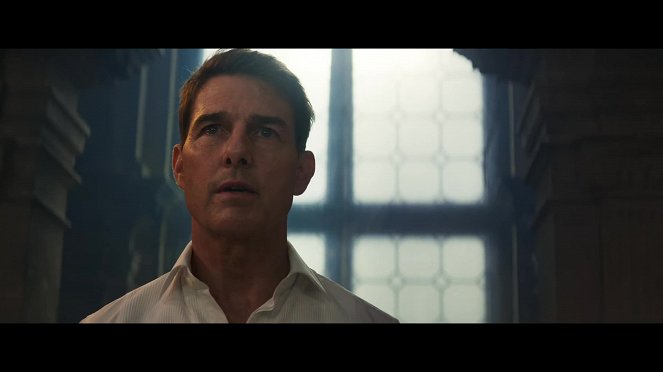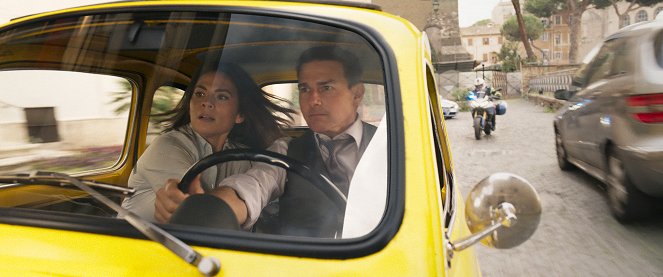Mission : Impossible - Dead Reckoning Partie 1
-
Mission : Impossible - Bilan mortel, première partie (plus)
Réalisation:
Christopher McQuarriePhotographie:
Fraser TaggartMusique:
Lorne BalfeActeurs·trices:
Tom Cruise, Hayley Atwell, Simon Pegg, Ving Rhames, Rebecca Ferguson, Vanessa Kirby, Esai Morales, Pom Klementieff, Henry Czerny, Shea Whigham (plus)VOD (4)
Résumés(1)
Dans Mission : Impossible - Dead Reckoning Partie 1, Ethan Hunt (Tom Cruise) et son équipe de l’IMF se lancent dans leur mission la plus périlleuse à ce jour : traquer une effroyable nouvelle arme avant que celle-ci ne tombe entre de mauvaises mains et menace l’humanité entière. Le contrôle du futur et le destin du monde sont en jeu. Alors que les forces obscures de son passé ressurgissent, Ethan s’engage dans une course mortelle autour du globe. Confronté à un puissant et énigmatique ennemi, Ethan réalise que rien ne peut se placer au-dessus de sa mission - pas même la vie de ceux qu’il aime. (Paramount Pictures FR)
(plus)Vidéo (12)
Critiques (12)
En première impression, un volet un peu anémique de la série qui, malgré sa durée la plus longue, offre moitié moins d’attraits que les meilleurs des épisodes précédents. La poursuite en voiture à Rome n’a rien de révolutionnaire et la scène du train est une redite du premier Mission impossible, avec en prime une version modifiée de la scène la plus palpitante du Monde Perdu de Jurassic Park. MAIS ! Lors d’un second visionnage, Dead Reckoning, Partie 1 est l’épisode qui m’a le plus diverti de tous les volets de la série grâce à son intrigue : la parfaite actualité du sujet avec la menace de l'intelligence artificielle ; la constellation de personnages tirés des précédents volets, y compris Kittridge du premier film ; Gabriel, le nouveau méchant ultime qu’Ethan Hunt a deux fois plus de raisons de haïr plus que tout au monde ; l’émotion sincère de la scène sur le pont Conzafelzi de Venise ; la nouvelle beauté Hayley Atwell, parfaitement assortie à Tom Cruise sur le plan de l’alchimie à l’écran ; et de nombreux détails pleins d’humour et d’imagination venant agrémenter les scènes qui semblent au premier abord moins innovantes – l’aéroport, la poursuite à Rome, l’incorporation du célèbre saut en moto dans la scène du train, et le final cinématographiquement quasi-organismique, qui transforme la scène du Monde perdu citée plus haut en un authentique frisson de film à grand spectacle… Et nous n’en sommes qu’à la moitié du film ! Si la deuxième partie monte en puissance comme Cruise et McQuarrie savent qu’elle doit le faire, Dead Reckoning deviendra l’épisode alpha de la franchise et lui donnera peut-être une nouvelle direction pour une livraison en plusieurs parties des futures missions impossibles d’Ethan Hunt. La nouvelle selon laquelle Tom Cruise prévoit de les tourner jusqu’à l’âge de 80 ans m’a absolument ravi.
()
The echo of the 90s, sending postcards about villainous AI through a time machine, sometimes appears to have the upper hand over the audience, but do not be lulled by the admitted stupidity, because the running scout Cruise and McQuarrie send it uncompromisingly into the present. It's not about WHAT, but HOW. Seeing a film that layers action scenes with stunt attractions, as well as plot twists of "good guys vs. bad guys vs. (other) bad guys," is an absolute delight for the audience. If Fallout is an amusement park of action entertainment, Dead Reckoning is the top form of creative concentration. Venice may be an early peak, but the climax of the episode with the trains, when the appreciation of the second part of the game "Uncharted" is realized, ultimately closes it off as the peak of this year's popcorn entertainment and easily parks this part of the film series behind the unattainable Rogue Nation.
()
More graphically than the previous instalments of the M:I franchise, Mission: Impossible – Dead Reckoning Part One raises concerns associated with the future of humanity and of Hollywood. The film, whose main villain is an extraordinarily powerful artificial intelligence, was released to cinemas during the dual strike of Hollywood actors and writers, who in addition to fair compensation also demanded a guarantee that they would not be replaced by modern technologies. The computer-generated illusions in the film threaten the approach to truth and relativise the ethical categories of good and evil. Ethan Hunt/Tom Cruise is naturally the only safeguard against machines taking over the world, the last link holding human society together (this is literally true in the final action scene, when his partner uses him as a ladder). What awaits him is a confrontation with the most powerful adversary he has faced yet, which collects our best-hidden secrets, reshapes reality and is everywhere and nowhere. In other words, he will have to take on a (false) god, whose interests are represented by a villain with the biblical name of Gabriel, and the key to controlling it is in the shape of a cross. ___ Though few people in Hollywood today are able to so effectively evoke the dizzying feeling of forward motion as a running Tom Cruise, Dead Reckoning is to a significant extent a film of reversions, to the old faces and analogue technology of the Cold War period, to the protagonist’s past and to the skewed angles of De Palma’s paranoid first Mission: Impossible. And even deeper into the past. To The General, Hitchcock’s comedy spy thrillers and related 1970s caper comedies like What’s Up, Doc? McQuarrie combines the structural principles of the cinema of attractions and classic Hollywood, but he intensifies the situations and takes them to such an extreme that even the characters sometimes laugh resignedly over their impossibility. Tension arises between the (unseen) classic and (self-reflexive) post-modern approach to style and narrative when the film alternately fulfils and defies our expectations, as it is playfully ironic at times and tragically romantic at other time. Similarly to the way Hunt defies the algorithm and how the protagonists are aided by disguises and advanced surveillance technologies, which fail repeatedly, however. In the end, they can rely only on human bodies, ingenuity and teamwork. ___ The characters’ distrust and suspicion toward what they see and hear is expressed in the dialogue scenes by the tilted camera shooting from up close and in decentred compositions of the actors’ faces. Sometimes without establishing shots, which, together with the hasty editing (including cross-axis jumps), intensifies the feeling of disorientation and the impossibility of determining what is true and who is running the show. At other times, usually while the next course of action is being planned, the camera uneasily circles the characters. Thanks to this, even the chatty explanatory sequences are thrilling and there are practically no statics moment in the film. The almost cubist composition of the picture occurs roughly at the midpoint of the narrative during the meeting of most of the key players at a party at Doge’s Palace in Venice. The characters’ dialogue as they try to figure out their adversaries’ motivations is edited in the rhythm of the diegetic background music. Their verbal shootout is reminiscent of a dance performance, as every camera movement is synchronized with the soundtrack. Also in other scenes, though not as conspicuously, the information conveyed is of comparable importance as the aesthetic pleasure of the interplay of shapes and lines. For example, during the chase through the narrow and dark streets and canals of Venice, the order of shots is not determined only by the continuity of the ongoing action, but also by the rhythmic alternation of contrasting and complementary angles and movements. ___ The episodically structured film traditionally comprises several massive action sequences, each of which having its own objective, obstacles and course of development. At the same time, they are firmly interlinked. Each one prepares us for what will happen next (which doesn’t always go according to the presented plan) and sets in motion another notional cog in the flawlessly tuned mechanism. The chosen locations also complement each other, as they give the characters less and less room to manoeuvre (from an expansive multi-level airport to a closed train). Almost every sequence works with a tight deadline and the necessity of precise timing, both across the given sequence and in its constituent parts (for example, the necessity of escaping from the car before it gets destroyed by an oncoming metro train at the end of the Rome sequence). ___ Unlike in blockbuster comic book adaptations and the high-octane, progressively dumber Fast & Furious movies, the human element is never overshadowed by the shootouts and explosions in Dead Reckoning. On the contrary, they are doubly suspenseful thanks to the chemistry between the believable characters. Their characterisation, which is carried out without pauses in the action or during their preparations for the next task, is skilfully connected with certain recurring motifs and props (e.g. Hunt’s lighter, the passing around of which among the characters reflects the development of the relationship between Grace and the protagonist). That’s what the franchise is about, as Cruise doesn’t hesitate to risk his own life again and again with maniacal determination in order to convince us that an intelligent machine can never do anything as spectacular as a human (or a team of humans) can do. In the latest instalment of the M:I franchise, which is the most narratively harmonious and stylistically experimental of the lot, he does this for the first time not only in the subtext, but in the foreground. The time for subtlety has passed. 95%
()
(moins)
(plus)
HE’S RUNNING AGAIN, at a nice heroic pace, knees right up (yeah, right Tom, we know you're an eternal youngster, you don't have to keep reassuring us so blatantly). The film itself is a succession of good action sequences, glued onto a stupid skeleton that seems to have fallen out of a spy movie from the 60s, the ones that were so beautifully parodied later. I found the concept of the Entity utterly ridiculous.
()
Some brilliantly overblown action sequences in a generally problematic film for me. MI may look deadly serious, fateful, whatever, but I'm afraid we're already on the level of the Fast and Furious franchise in terms of plot intelligence. The whole AI stampede is utterly ludicrously contrived, the plot still has to be explained verbatim by one of the characters to get the viewer to at least frame it, but it doesn't help much. If we forget about the craftsmanship and just think about the plot itself... I don't believe it makes sense to anyone. For example the dialogue exchange at the Venetian party, WTF? We spend over two and a half hours looking for a key, next thing we know we're diving towards a submarine for over two and a half hours, then Cruise shoves the key up the AI's ass and it goes nuts or something. 83 percent and 620th best movie, My God.
()



Annonces